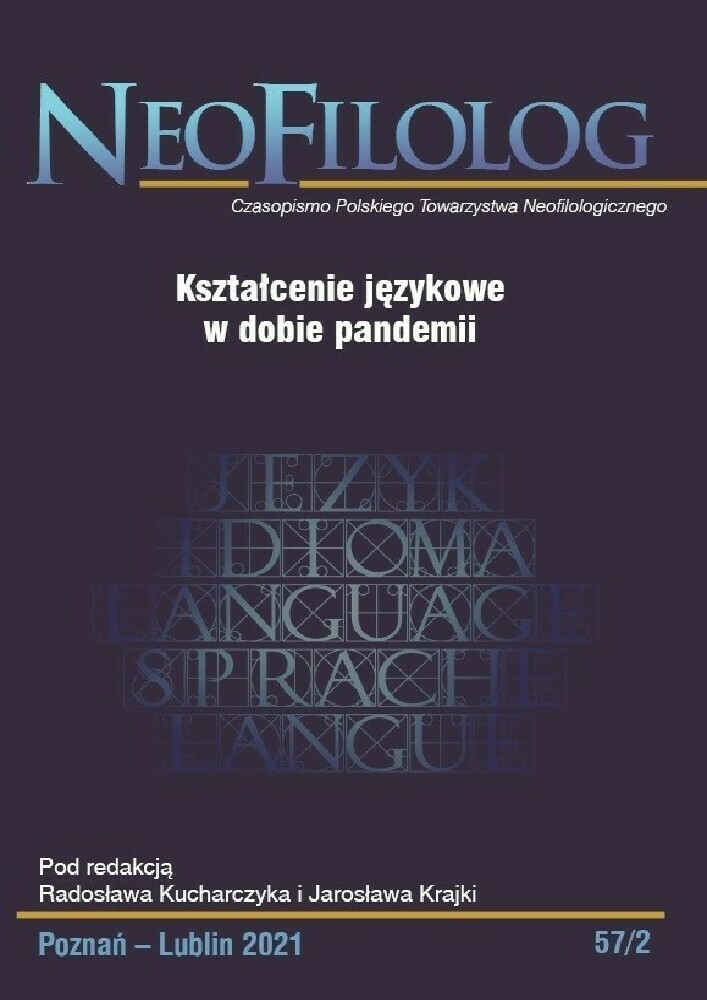Abstract
At the Institute of Applied Linguistics (ILS) as at the whole of Adam Mickiewicz University in Poznan (UAM), full-time classes have been suspended as of 11 March 2019 due to the declaration of a pandemic, and till now (April 2021) are being held in remote mode. The need to switch from full-time to remote teaching therefore fell on both lecturers and students suddenly, causing temporary disorganisation of the teaching process. In a short time, however, both parties had to organise themselves anew and take up the hitherto unknown challenge of learning and teaching completely at a distance, even though the form of communication itself, via the Internet, was not new. The problems this posed and the conclusions it led to are presented in this article. The aim of the article is to reflect on the form and implementation of distance learning in selected subjects of the Bachelor's and Master's degree courses in Applied Linguistics at ILS in the academic years 2019/20 and 2020/21, based on the experiences of the authors of the article and the participating students, as well as to draw conclusions on the effectiveness of this form of teaching and raising the quality of education in the subjects studied.
References
Atteslander P. (2008), Methoden der empirischen Sozialforschung. Berlin: Erich Schmidt Verlag.
Bałaban K. (2018), Nauczanie hybrydowe w nauce języków obcych. „Anuari de filologia. llengües i literatures modernes”, 8 (2018), s. 21–26.
Böttcher R. (2013), Nauczanie hybrydowe – przyszłość nauki języków obcych. „Języki Obce Szkole”, 2, s. 92–97.
Kautz U. (2000), Handbuch Didaktik des Übersetzens und Dolmetschens. München: Iudicium.
Krajka J., Białek K. (2021), O stylach dydaktycznych w edukacji zdalnej w teorii i praktyce. „Języki Obce w Szkole”, 1, s. 5–15.
Pałczyńska A. (2021), Godne polecenia narzędzia internetowe do nauczania słownictwa, gramatyki i tworzenia wypowiedzi ustnych. „Języki Obce w Szkole”, 1, s. 33–38.
Schiek D. (2014), Das schriftliche Interview in der qualitativen Sozialforschung. „Zeitschrift für Soziologie”, 5 (2014), s. 379–395.
Scholz Ch. (2014), Generation Z: wie sie tickt, was sie verändert und warum sie uns alle ansteckt. Weinheim: Wiley.
Siemak-Tylikowska A., Słomczyński M. (2011), Czy kształcenie zdalne potrzebuje nowej dydaktyki? (w:) Migdałek, J., Stolińska, A. (red.), Technologie informacyjne w warsztacie nauczyciela − nowe wyzwania edukacyjne. Kraków: Wydawnictwo Naukowe Uniwersytetu Pedagogicznego, s. 31–41.
Śmiałek E. (2021), Narzędzia MS Teams w pracy nauczyciela języka obcego. „Języki Obce w Szkole”, 1, s. 25–31.
Żarczyńska-Dobiesz A., Chomątowska B. (2014), Pokolenie ,,Z” na rynku pracy – wyzwania dla zarządzania zasobami ludzkimi. „Prace Naukowe Uniwersytetu Ekonomicznego we Wrocławiu”, 350, s. 405–415.
NETOGRAFIA
https://www.gov.pl/web/edukacja-i-nauka/ksztalcenie-zdalne-na-uczelniach [25.04.2021].
https://owko.amu.edu.pl/ [28.04.2021].
License
Copyright (c) 2021 Lucyna Krenz-Brzozowska, Hanka Błaszkowska

This work is licensed under a Creative Commons Attribution-NoDerivatives 4.0 International License.
Authors
Authors of texts accepted for publication in Neofilolog are required to complete, sign and return to the Editorial team’s office the Agreement for granting a royalty-free license to works with a commitment to grant a CC sub-license.
Under the agreement, the authors of the texts published in Neofilolog grant Adam Mickiewicz University in Poznań a non-exclusive, royalty-free license and authorize the use of Attribution-NoDerivatives 4.0 International (CC BY-ND 4.0) Creative Commons sub-license.
The authors retain the right to the free disposal of the work.
Users
Interested Internet users are entitled to use works that have been published in Neofilolog since 2017, under the following conditions:
▪ attribution – obligation to provide, together with the distributed work, information about the authorship, title, source (link to the original work, DOI) and the license itself.
▪ no derivatives – the work must be preserved in its original form. Without the author's consent, it is not possible to distribute the modified work in the form of translations, publications, etc.
Copyrights are reserved for all texts published since 2017.
Miscellaneous
Adam Mickiewicz University in Poznań retains the property right as a whole (layout, graphic form, title, cover design, logo etc.).

